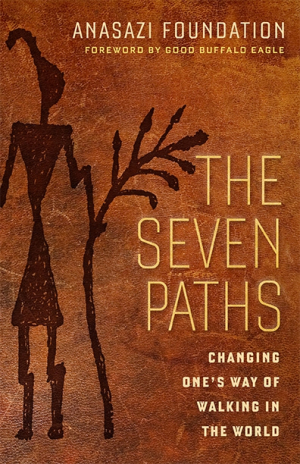The Seven Paths
Changing One's Way of Walking in the World
Simple, poetic, sophisticated prose relays ancient Native American wisdom that will inspire modern-day reflection.
Self-published over a decade ago and now available from a traditional publisher, The Seven Paths is the work of the Arizona-based Anasazi Foundation, a nonprofit organization that helps put children on a path to success by embracing nature. This powerful short book conveys a timeless message in story form about a tribesman who learns the consequences of walking away from his people.
The strength of The Seven Paths is its simplicity. Written in narrative form, the tribesman addresses the reader directly, recounting his spiritual journey. Along the way, he learns the importance of “the seven paths”—light, wind, water, stone, plants, animals, and we. The tribesman expresses himself in language that is at once poetic and philosophical, an attribute that makes the book particularly poignant. About the nature of light, he says, “Darkness within clouds the world without. He says stone asks a question: ‘What impressions and depressions will you leave on the people around you?’” He discusses the fact that good plants have their counterparts; if eaten, they make one ill. Of such plants, he writes, “Just as you must separate the good from the counterfeit in nature, so must you do in your life.”
Ultimately, the tribesman, who had left his home in anger, learns much from his encounters with nature. He returns to his people because he finally recognizes the importance of “The Path of WE.” He writes, “We are all connected. WE [others] appear as WE [ourselves] are. To see another is to see one’s self.”
The writing is sparse and uncomplicated, yet elegant and meaningful. The tribesman’s universal message is one to be savored by all. For example, “If I was to move forward, I needed to leave all that was backward behind. Perhaps in this regard, as well, you and I are alike. Perhaps there are aspects of your life that need to be started anew.” The engaging text is enhanced by the illustrations, reminiscent of primitive cave paintings, that appear at the beginning of each chapter.
The Seven Paths achieves a dual purpose. First, it displays the philosophical sophistication and reverence for the Earth of the Native Americans. This alone is worthy of appreciation from a cultural perspective. Second, the book serves as a wake-up call to humanity. It shines a light on the way some people treat each other and the way humans in general treat the Earth. In this regard, The Seven Paths can serve as a reminder, perhaps even a warning, that “there is a power in nature that man has ignored,” as the book’s preface states. This is a book of enlightenment and spirit that the reader will not soon forget.
Reviewed by
Barry Silverstein
Disclosure: This article is not an endorsement, but a review. The publisher of this book provided free copies of the book to have their book reviewed by a professional reviewer. No fee was paid by the publisher for this review. Foreword Reviews only recommends books that we love. Foreword Magazine, Inc. is disclosing this in accordance with the Federal Trade Commission’s 16 CFR, Part 255.

